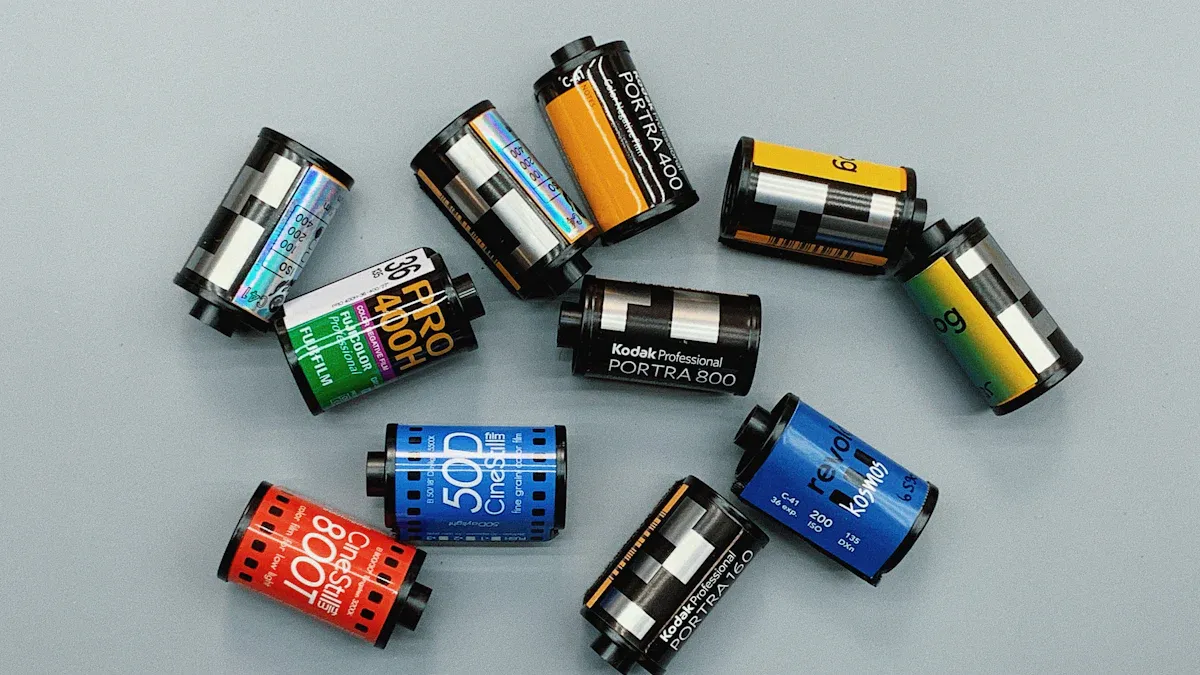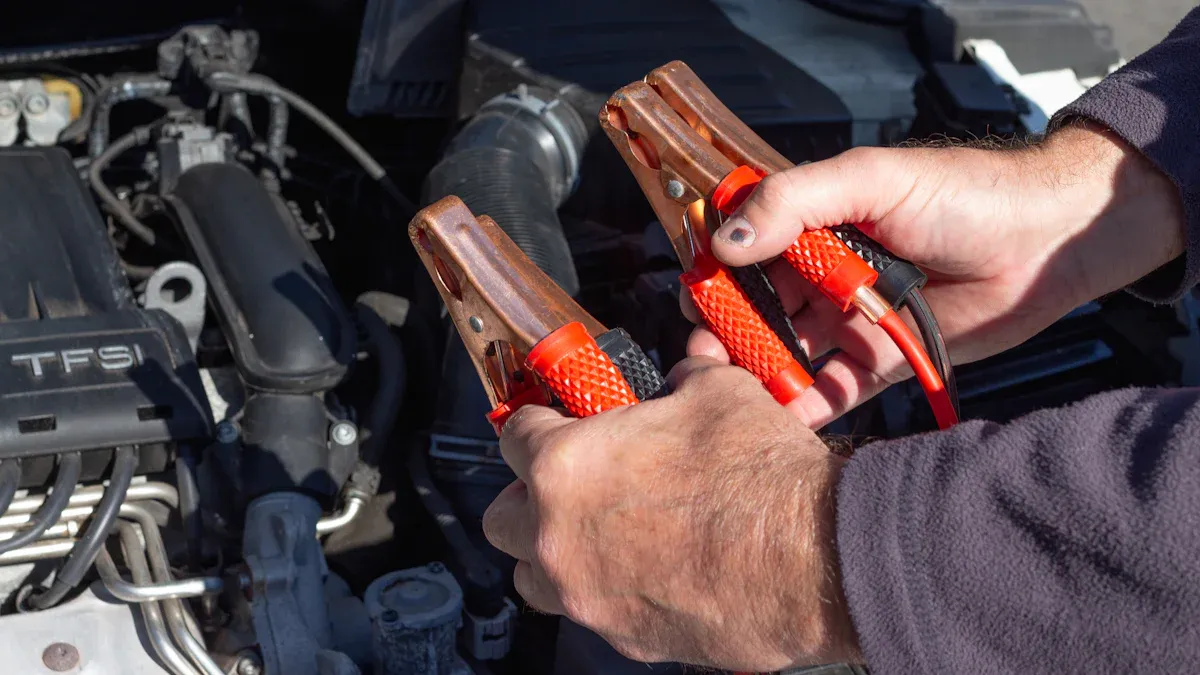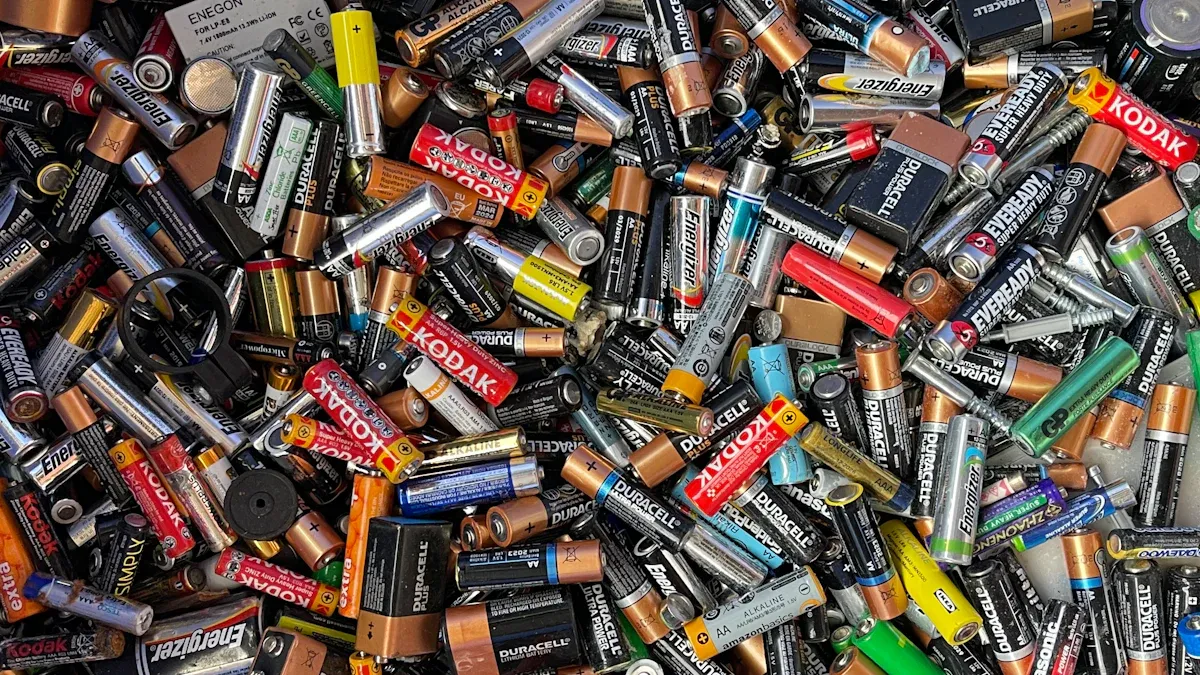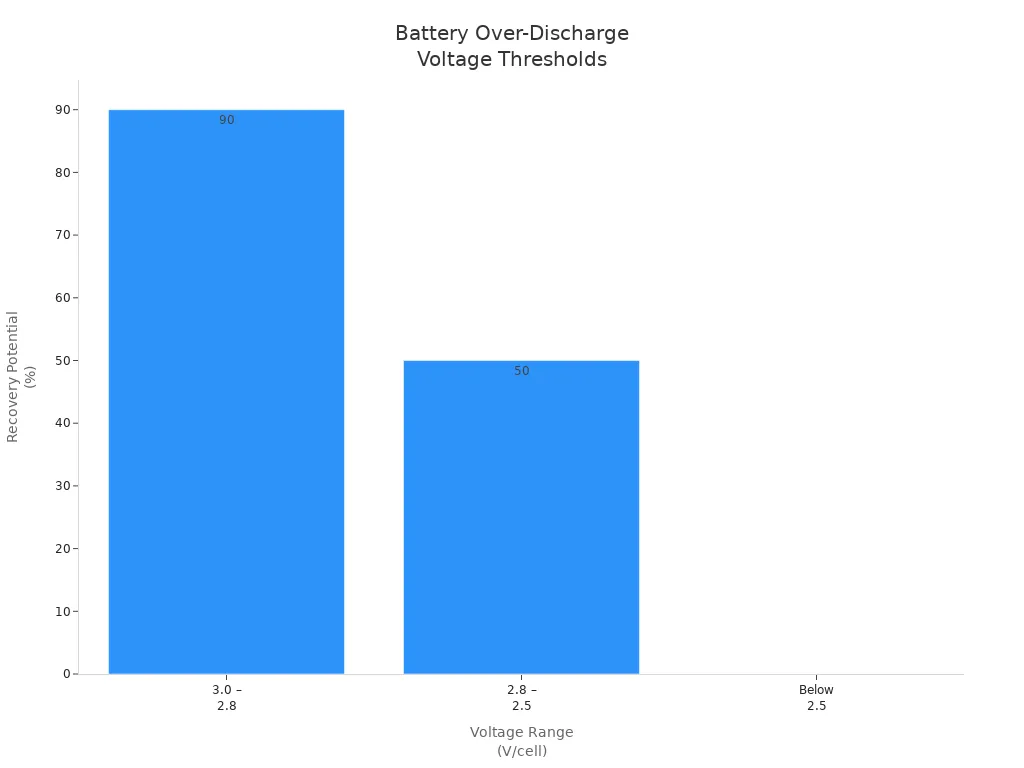
If you suspect you have over-discharged batteries, stop using them immediately. Many people believe a fully discharged battery cannot recover, but modern lithium-ion batteries often regain capacity if you use the right charging method. It’s important to understand that over-discharging batteries by letting them reach zero charge or performing regular deep discharges will reduce their lifespan and lower their capacity. Never rush to recharge or use a lithium battery if you notice swelling or leaks. Some think fully draining a battery before charging helps, but this actually shortens battery life and damages capacity. For lithium-ion batteries, keeping the charge above zero and avoiding over-discharging batteries protects both capacity and longevity. Always follow safe charging and discharging habits to extend battery life and maintain strong capacity.
Immediate Actions

Stop Use
When you notice signs of over-discharging batteries, you must stop using the battery right away. Continuing to use a lithium-ion battery after it has been deeply discharged can cause serious damage. Deep discharges below 2.5 volts lead to internal metal plating, which can create short circuits. This makes the battery unsafe and unusable. Experts warn that trying to recharge a deeply discharged lithium-ion cell can result in fire or even catastrophic failure. Most battery packs include protective circuits to prevent operation below this voltage, but you should never rely only on these systems.
Tipp: If your device suddenly loses power or the battery drains much faster than normal, this may signal a dangerous depth of discharge. Remove the battery from use immediately to protect both the battery and your safety.
Auf Beschädigungen untersuchen
After stopping use, inspect the battery for any visible or physical signs of damage. Over-discharged batteries often show clear warning signs. Look for swelling, puffiness, or bulging of the battery pouch. Discoloration of the casing, leakage, or a strong chemical odor like nail polish remover are also signs of damage. You might notice dents, scratches, or exposed material. Loose or damaged wires can also appear. If you see any of these signs, the battery has likely suffered from a dangerous depth of discharge and should not be used again.
- Swelling or expansion of the battery
- Discoloration or staining on the casing
- Leakage or venting of electrolyte
- Odor similar to acetone
- Cracks, bulges, or misalignment in the device case
- Excessive heat or strange noises during charging or use
- Sudden loss of battery capacity
These signs mean the battery has lost capacity and may pose a safety risk. Over-discharging batteries can cause irreversible damage, including corrosion of internal parts and increased risk of internal short circuits. If you notice any of these problems, do not attempt to recharge or reuse the battery.
Move to Safety
If you find any damage or if the battery feels hot, move it to a safe location. Place the battery on a non-flammable surface, such as concrete or ceramic tile. Keep it away from flammable materials, children, and pets. Do not handle a leaking or swollen battery with bare hands. Use gloves or tools to avoid contact with chemicals.
Anmerkung: Over-discharged lithium-ion batteries can experience thermal failure, which may cause a sharp temperature rise, smoke, or even fire. Always prioritize battery safety by isolating the battery and seeking professional help if you feel unsure.
You should never try to charge a damaged or deeply discharged battery. The risk of fire or explosion increases with each attempt. Proper handling and quick action can prevent accidents and protect your devices, your home, and your life. Monitoring the depth of discharge and battery capacity helps you avoid these dangers in the future. Remember, lithium-based batteries require careful charging and discharging to maintain their life and safety.
Risks of Over-Discharging Batteries

Irreversible Damage
When you over-discharge lithium-ion batteries, you risk causing permanent harm. If you let the battery voltage drop below a safe threshold, such as 2.5 volts, the anode material can dissolve into the electrolyte. When you try to recharge, this material may move into the separator, which can cause internal short circuits. The cathode can also release oxygen, which escapes and does not return, leading to chemical damage that you cannot reverse. You may notice that the battery casing changes shape or swells. These changes happen because the electrode materials expand and contract during charge and discharge cycles. Over time, this process causes the electrodes to break apart, which lowers battery capacity and can cause short circuits. If you keep discharging lithium-ion batteries too deeply, you will see a drop in battery life and fewer discharge cycles. You may lose up to half the battery’s capacity if you let it fully discharge often. Always keep the charge above 20% to avoid these problems.
- Voltage below 2.5V causes instability and loss of capacity.
- Chemical reactions damage the electrodes.
- Internal resistance rises, making charging less effective.
- Physical changes in the casing can lead to leaks or failure.
- Full discharge can cut battery lifespan by 30% to 50%.
Sicherheitsgefahren
Over-discharging batteries can create serious safety risks. When you deeply discharge a lithium-ion battery, the electrolyte can break down and form flammable gases. If you try to recharge a damaged battery, these gases can cause a fire or even an explosion. You may also see the battery swell, crack, or vent gas. If the battery gets too hot, it can enter thermisches Durchgehen, which means it heats up uncontrollably and may catch fire. Sometimes, battery parts can even shoot out during an incident, spreading flames. Fires from lithium-based batteries can restart even after you think they are out. Always watch for signs like bulging, cracking, or a sudden rise in temperature. If you see these, move the battery to a safe place and do not try to charge it.
- Electrical overload can cause short circuits or fires.
- Mechanical damage increases fire risk.
- Thermal overload from heat sources can trigger battery fires.
- Chemical exposure from leaks can be dangerous.
- Risk of reignition after a fire.
Battery Degradation
You will notice that over-discharging batteries leads to faster battery degradation. Surveys show that most problems come from poor energy management, failed battery management systems, or using batteries in ways they were not designed for. When you discharge a lithium-ion battery below its safe limit, you start a chain of damage. The current collectors can oxidize, and the internal resistance goes up. This makes charging slower and less effective. You will see a drop in battery performance, with less stable voltage and longer charging times. The depth of discharge affects how many discharge cycles you get before the battery fails. If you keep the battery between 20% and 80% charge, you can extend its life and keep battery capacity high. Self-discharge also increases as the battery ages, which means it loses charge even when not in use. If you ignore these signs, your battery will fail due to over-discharging and you will need to replace it sooner.
Tipp: Regularly check your battery’s charge level and avoid deep discharging to protect battery performance and extend battery life.
Recovery Options
Safe Recharging Methods
When you over-discharge a battery, you need to use safe recharging methods to protect battery life and performance. Not all batteries recover the same way. The right method depends on the battery chemistry and the depth of discharge. If you use the wrong battery charging method, you risk further damage or even fire.
- Use the charger recommended by the manufacturer. This ensures the battery management system works as designed.
- For lithium-ion batteries, avoid discharging below 25%. If you do, recharge promptly to prevent permanent capacity loss.
- Always use lithium-specific chargers with smart charging logic. These chargers control the charging rate and prevent overheating.
- Charge lithium-ion batteries at a controlled rate, usually between C/4 and C/2. This helps maintain battery capacity and extends battery life.
- Do not charge lithium-ion batteries to 100% every time. Charging up to 80% helps prolong battery life and keeps performance stable.
- For lithium iron phosphate (LiFePO4) batteries, use a charger designed for lithium chemistry. Watch the charge cutoff current to avoid overcharging.
- Lead-acid batteries need trickle charging or low-current charging after deep discharge. This helps restore battery capacity without overheating.
- Keep batteries in a cool, dry place during charging. Avoid charging in very hot or cold environments, as this can harm battery performance.
- Store lithium-ion batteries at about 50% charge if you will not use them for a long time. This prevents capacity loss and corrosion.
- Clean battery terminals regularly to prevent corrosion and keep battery charging safe.
Tipp: Always check the battery management system for errors before starting battery charging. Smart charging ICs help monitor safety and prevent overcharging.
You should avoid using lead-acid chargers for lithium batteries. This can cause damage and reduce battery capacity. If you notice the battery does not hold a charge or the depth of discharge is too great, stop charging and inspect for damage.
When to Discard
Sometimes, you cannot recover a battery after deep discharging. You need to know when to discard a battery to protect your safety and the environment. Experts use voltage thresholds and physical signs to decide when a battery is no longer safe.
| Voltage Range (V/cell) | Damage Severity | Recovery Potential |
|---|---|---|
| 3.0 – 2.8 | Mild Discharge | About 90% reversible |
| 2.8 – 2.5 | Deep Discharge | 40–60% capacity loss |
| Below 2.5 | Critical Failure | 0% recovery, hazardous waste |

If the battery voltage drops below 2.5V per cell, you should discard it. At this depth of discharge, irreversible damage occurs, including copper dissolution and breakdown of the separator. For LiFePO4 batteries, the minimum safe voltage is about 2.0V per cell. If you see swelling, leakage, or a 5% increase in thickness, discard the battery right away. These signs mean the battery is unsafe and cannot recover battery capacity or performance.
Anmerkung: Never throw batteries in the trash. Improper disposal causes soil and water pollution. Lithium and lead-acid batteries release toxic chemicals that harm wildlife and people. Always recycle batteries at approved centers.
Legal rules require you to treat lithium-ion batteries as hazardous waste. In the United States, you must follow the Resource Conservation and Recovery Act (RCRA). This law says you must remove hazardous parts before disposal. You must also meet standards for metals like nickel and manage organic parts safely. If you do not follow these rules, you risk fines and environmental harm.
Professional Help
If you feel unsure about recovering a battery after deep discharging, seek professional help. Trying to recover a deeply over-discharged lithium-ion battery on your own can be dangerous. The battery chemistry may have permanent damage, such as lithium plating or dendrite growth. These problems can cause short circuits, fire, or even explosions. Commercial battery management systems often mark these batteries as permanently damaged to prevent unsafe reuse.
Repair professionals report common mistakes during battery recovery:
- Replacing batteries without proper testing leads to wasted money.
- Ignoring the root cause of battery failure, such as sulfation or digital faults, results in poor performance.
- Using commercial desulfators or additives rarely restores battery capacity and may waste time.
- Failing to measure battery capacity, internal resistance, and self-discharge before recovery attempts.
- Not matching the recovery method to the battery chemistry reduces the chance of success.
- Discarding batteries based only on age or vague guidelines, not actual battery performance.
Alert: If you see swelling, leaks, or the battery does not recover voltage after safe charging, do not try to fix it yourself. Contact a certified battery management or recycling center.
Improper disposal of over-discharged batteries causes environmental damage. Lithium batteries leak metals and chemicals into soil and water. This harms ecosystems and human health. Lead-acid batteries release lead and sulfuric acid, which are also dangerous. Fires at recycling plants have started from mishandled batteries, leading to recalls and safety investigations.
You protect your safety and the environment when you use proper battery management, follow safe battery charging, and seek expert help for deep discharge problems. Responsible battery disposal and recycling help reduce pollution and support a healthy planet.
Preventing Over-Discharging Batteries
Use Protection Circuits
You can prevent over-discharging by using protection circuits and battery management systems. These systems monitor your battery and stop discharging when the voltage drops too low. For lithium-ion batteries, protection circuits use MOSFETs and ICs to watch each cell’s voltage. If the voltage falls below a safe level, the circuit disconnects the load. This protects battery capacity and prolongs battery life. Lead-acid batteries use simpler hardware for over-discharge protection. Both types help you avoid deep depth of discharge and keep your battery safe.
| Merkmal | Lithium-Ion BMS | Lead-Acid BMS |
|---|---|---|
| Complexity | Advanced software and hardware integration | Primarily hardware-focused |
| Safety Protocols | Extensive safety features including over-discharge protection | Basic overcharge/over-discharge protection |
| Voltage Monitoring | High precision required | Lower precision requirements |
| Thermal Management | Active cooling and heating systems | Passive cooling or temperature compensation |
| Zellausgleich | Essential for maximizing lifespan | Not typically required |
Tipp: Battery management systems act as a caretaker for your battery. They monitor voltage, current, temperature, and state-of-charge to prevent deep discharging and protect battery life.
Maintain Charge Range
You should keep your battery’s state-of-charge between 20% and 80%. Avoid letting lithium-ion batteries drop below 20% or charging above 80%. This practice reduces stress, slows battery capacity loss, and increases discharge cycles. Deep discharging below 20% causes rapid voltage drops and can trigger shutdowns. Overcharging or keeping batteries at 100% for long periods also harms capacity and performance. By following this charge range, you help prolong battery life and maintain strong performance.
- Recharge batteries promptly if they fall below 25%.
- Use partial charging cycles instead of full charges.
- Store batteries at about 50% charge for long-term care.
Regular Monitoring
Regular monitoring is key to good battery care. Use a battery management system or a dedicated monitor to check voltage, current, and state-of-charge. These tools alert you to low battery capacity or deep discharging before damage occurs. Many systems offer alarms or notifications to warn you of problems. You should also check battery health during routine maintenance. Store batteries in cool, dry places and recharge them at least once a year if not in use. This care prevents over-discharging and keeps battery performance high.
- Test battery health often to catch early signs of trouble.
- Use smart chargers designed for your battery type.
- Recharge stored batteries if charge drops below safe levels.
Anmerkung: Good battery care and management help you avoid deep depth of discharge, protect battery capacity, and prolong battery life.
When you over-discharge a battery, act quickly. Stop using the lithium-ion battery, check for damage, and move it to a safe place. Always use proper care and follow safe charging steps to protect battery life and capacity. Experts say you should never use a damaged lithium-ion battery. Tape the terminals, store the battery safely, and recycle it at a special center. Use a battery management system to watch charge levels and avoid deep discharge. Keep your Ladung zwischen 20% und 80% to protect capacity and extend life. Good management and regular care help you avoid problems.
- Use the right charging method for each battery.
- Monitor lithium-ion battery charge and capacity often.
- Store batteries in cool, dry places for longer life.
- Never throw lithium-ion batteries in the trash.
You can manage most battery issues with the right care and knowledge. Safe charging, good management, and regular checks keep your lithium-ion battery healthy and extend its life.
FAQ
What happens if you over-discharge a lithium-ion battery?
You risk losing battery capacity and shortening its life. Over-discharging can damage the battery. The battery may not hold a charge. You might see swelling or leaks. Charging a damaged battery can cause safety problems. Always check the battery before charging.
How can you safely recharge an over-discharged battery?
Use the correct charger for your battery. Start charging at a low current. Watch the battery for swelling or heat. If the battery does not recover charge or capacity, stop charging. Never force a charge. Protect battery life by following safe charging steps.
Can you restore battery capacity after deep discharge?
You cannot always restore full capacity. Sometimes, the battery loses life and cannot hold a charge. If the battery voltage stays low or the battery swells, you should not use it. Charging may help a little, but battery life will drop.
How do you prevent over-discharging your battery?
Keep your battery between 20% and 80% charge. Use a battery management system. Check the battery often. Avoid deep discharges. Store the battery at half charge if you will not use it for a long time. Good charging habits protect battery life and capacity.
Why does charging to 100% harm battery life?
Charging to 100% puts stress on the battery. This lowers battery capacity and shortens battery life. Try to keep the charge below full. Charging to 80% helps the battery last longer. You protect battery life and capacity with careful charging.

